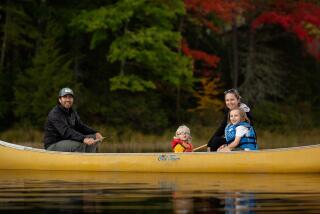The Motoring Adventure of a Lifetime--or a Fool’s Errand
- Share via
In 1907, Prince Scipione Borghese, accompanied by author Luigi Barzini and a mechanic, set out in a 40-horsepower Itala on the first Peking to Paris rally, a troubled odyssey that would last 60 days. Ninety years later, freelance journalist Genevieve Obert decided to participate in the Peking to Paris Motor Challenge as the driving partner of Linda Dodwell, a woman she barely knew.
Although Obert often refers to Barzini’s account of the earlier journey, the 1997 rally didn’t precisely follow Borghese’s trail: The contemporary participants rode through China, Tibet, Nepal, India, Pakistan, Iran, Turkey and Greece, to Italy by ferry, then on to Austria, Germany and France, over the course of six weeks starting in September. The prince had traveled through China, Outer Mongolia, Siberia, Russia, Germany and France.
In 1907, Borghese’s Itala represented state-of-the-art automotive technology. Obert and Dodwell drove a 1968 Hillman Hunter with a 1,725-cubic-centimeter engine. The 95 other vehicles that set out from Beijing included a 1907 LaFrance Hooper sports, a 1915 Vauxhall Prince Henry, a 1927 Mercedes 630K sports, a 1942 Ford Willys Jeep MB and a 1950 Rolls-Royce Silver Dawn.
*
The idea of subjecting these rare and valuable cars to thousands of miles of unpaved roads will make some auto buffs shudder. It is hardly surprising that the vehicles developed a lot of problems--engine malfunctions, suspension troubles, excessive tire wear--on top of the cumulative effects of mud, water, gravel and sand. Replacement parts were difficult to come by, and repairs often had to be jury-rigged by local mechanics and welders.
Given the distances and places involved, it is also not surprising that many aspects of the rally were poorly organized: The routes were not described accurately, the check-in points were often hard to find, and the accommodations ranged from luxurious to squalid.
But Obert wasn’t particularly well-prepared either. She entered the rally almost on a whim; Dodwell had originally planned to enter with another woman, who dropped out on short notice. Obert had some experience in rally driving, but neither woman knew much about the geography, languages, politics and other details of the countries they would be visiting.
The most entertaining sections of “Prince Borghese’s Trail” focus on the rally itself: the contrasts between the treacherous, unpaved roads and the surprisingly modern highways the drivers encountered in Asia, and the litany of problems the Hillman Hunter developed (glitches in the electrical system, a recalcitrant clutch, the battered alignment that wore out hard-to-find tires). (For the record, Obert and Dodwell finished the race, coming in 32nd.)
Obert also chronicles the myriad breakdowns the other participants encountered and the personality clashes that led to at least one fistfight, although readers may have trouble telling the various rally teams apart.
The accounts of the beauty (and desolation) of some of the Asian and European landscapes are lively and vivid, but Obert is less effective as a travel writer than as an automotive journalist. She sees Afghani women swathed in the tent-like burqah imposed by the fundamentalist Taliban regime and notes the dissatisfaction some Iranian women express at being forced to wear the chador, but her observations are neither particularly original nor insightful.
*
Obert’s feelings about the rally are decidedly ambivalent. She concludes: “The Peking to Paris Motor Challenge was a huge, flamboyant action, an ostentatious display of Western wealth, but also a loud exhaust-tinged call for international cooperation. Our long drive was an act of connection.”
Participating in the rally was a decidedly ostentatious gesture--the entry fee was 20,000 pounds sterling, or more than $32,000, plus a $4,000 accommodation fee and numerous incidental expenses.
But the only connections that occurred in most of the countries took place between wealthy motoring enthusiasts and impoverished mechanics.
After complaining about the smog the drivers encountered in industrial regions of China and India, Obert concedes that the old cars in the rally emit high levels of pollutants.
When she returns to her home in Santa Cruz, she damns the sport-utility vehicles she sees outside her children’s school as “ostentatious displays of environmental ignorance.” Two paragraphs later, Obert, her husband and their two children hop into “our 1975 Chevy car hauler (with our Fiat in the back)” and motor across North America--hardly the actions of a committed environmentalist.
Perhaps because of the author’s ambivalence, the Peking to Paris Motor Challenge sometimes feels like the adventure of a lifetime--and sometimes like a damn-fool stunt.
Charles Solomon can be reached at highway1@latimes.com.
More to Read
Sign up for The Wild
We’ll help you find the best places to hike, bike and run, as well as the perfect silent spots for meditation and yoga.
You may occasionally receive promotional content from the Los Angeles Times.






